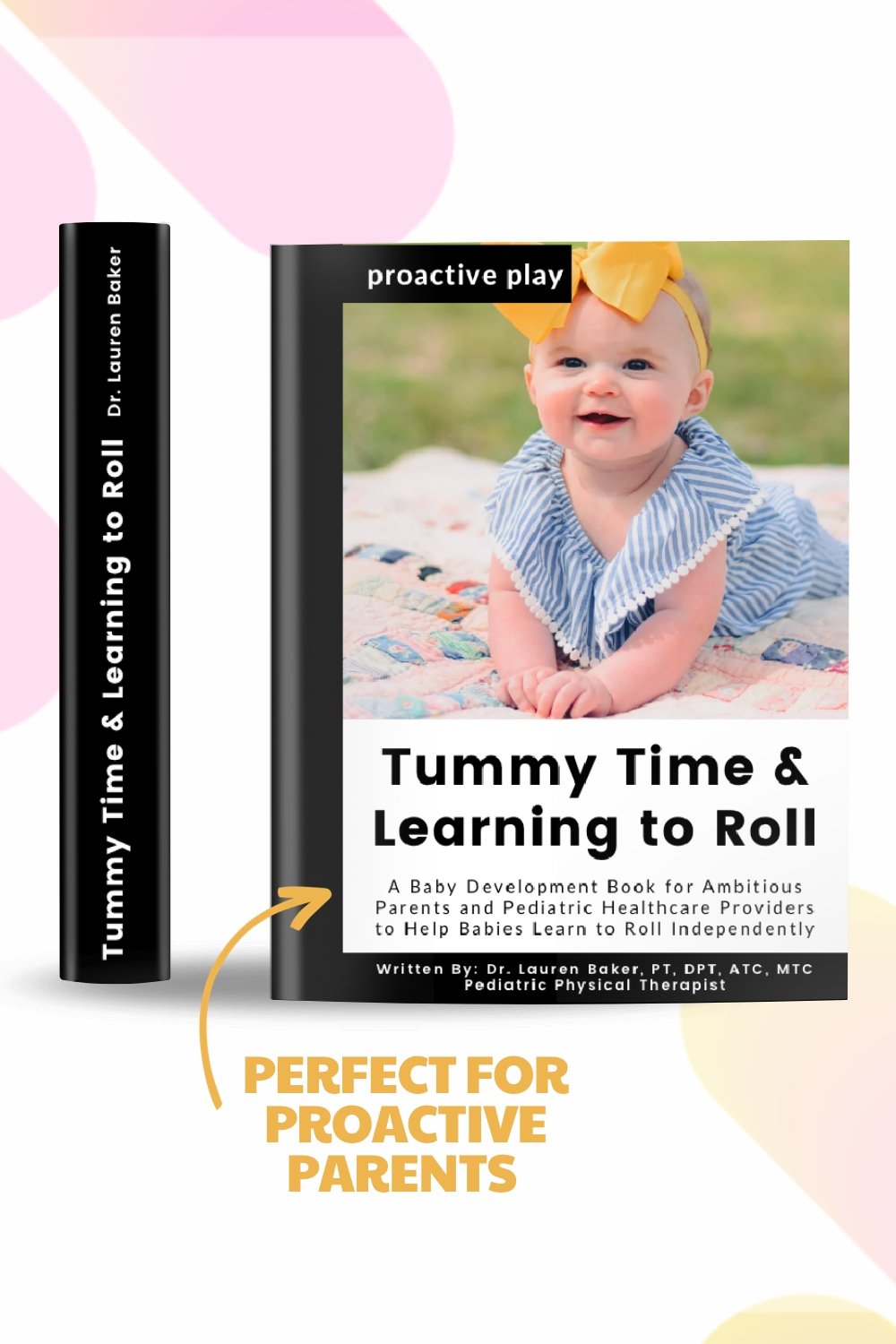Exercises for Newborn Babies and Other Ways to Strengthen a Baby’s Neck
this blog contains affiliate links
Hey there! I’m Dr. Lauren Baker, a pediatric physical therapist and today we are diving into the world of newborn movement. We’re all about nurturing your little one’s physical development right from the start, especially because I often hear parents talk about how tough it can be to know exactly how to play with a newborn.
I’m here to share a super simple exercise that’s perfect for newborns up to four or five month olds. This routine is all about ensuring symmetrical movement and laying a strong foundation for future milestones like rolling, all while keeping an eye out for any signs of asymmetry or conditions like torticollis.
Understanding Torticollis
Before we jump into the exercises, let’s talk a bit about torticollis. This condition involves a tilt of the head to one side with a rotation to the opposite side due to muscle tightness, typically in the sternocleidomastoid muscle.
It’s a full-body issue that can affect more than just the neck, including the arms, shoulders, and even the pelvis.
Right vs. Left Torticollis:
Left Torticollis: A tilt to the left with rotation to the right (or preferred rotation to the right) indicates an issue with the left sternocleidomastoid or left torticollis.
Right Torticollis: A tilt to the right with rotation to the left (or preferred rotation to the left) indicates an issue with the right sternocleidomastoid or right torticollis.
The Importance of Early Treatment of Torticollis
Catching and addressing any potential issues early can significantly reduce therapy time and ensure smoother development down the road. Ideally, babies with any tilt or rotation preference should see a pediatric physical therapist before one month of age, if at all possible.
If your baby is already older than one month and you are noticing a tilt, Torticollis is still fairly easily to treat in the 0-5 month range, after 5 months it gets progressively difficult; however, should still be treated.
A Simple Newborn Exercise: Back to Sidelying
This exercise is fantastic for newborns and can be started right away. It’s designed to encourage equal movement on both sides, preparing them for rolling and preventing any asymmetries. It also is a great way to introduce vestibular input in the horizontal plane, which will set them up for rolling back to side and back to belly.
How to Do the Exercise:
Start Position: Lay your baby on their back.
Tuck the bottom: gently tuck your baby’s bottom so that their back is rounded (see the video below for real life example!)
Movement: Gently roll your baby from their back to their side, alternating sides. Use your hands to support their pelvis, and ensure their head follows the movement naturally. If the head stays tilted the other direction, gently encourage the head to stay in line with the body before rotating the opposite way.
Frequency: Perform this movement for 1-2 minutes or 10-20 repetitions. Aim for a duration that feels comfortable for your baby, giving them breaks as needed.
Tips for Success:
If your baby struggles to tilt their pelvis up, it might indicate they’re not ready for this exercise. In that case, consider stepping back to focus on pelvis tilting exercises before attempting this one again. My book, Tummy Time and Learning to Roll explains why tilting of the pelvis might be difficult and walks you through different exercises you can do to help decrease this possible tightness or discomfort with this position.
Working with Twins or Older Babies
The principles of this exercise remain the same as your baby grows. For older babies or twins, the focus on tucking the pelvis and ensuring the head follows the body’s movement is key.
For twins especially, this exercise can help you notice if there is any potential tightness in one twin vs the other, often due to crowding in utero one twin might be more susceptible to muscle tightness than the other, or to be honest both are at risk, so monitoring symmetrical movement can be helpful to catch any tightness early.
Adjust your support based on your baby's size and strength, always aiming for smooth, comfortable transitions from back to side. Once babies start rolling on their side on their own, this exercise needs to be upgraded to rolling exercises!
What to Do If You Notice Difficulties
If you find this exercise challenging for your baby, or if you observe any signs of discomfort, asymmetry, or difficulty in following the movement with their head, it may be a good sign to consult a pediatric physical therapist. This could help address any underlying issues early on. If you notice a head tilt, rotation preference, or flat spot on the back of the head consult a pediatric PT as soon as possible.
for the most comprehensive information including a demonstration on a newborn, please watch the video below.
TIMESTAMPS:
1:28 newborn exercise: back to sidelying
3:25 exercise with 2-3 month old twins
7:15 recap of most important aspects
7:18 what to do if baby has difficulty tucking pelvis
7:35 exercise with 6 month old
TOY IDEAS:
Pacifier
Best Toys for Babies Learning to Roll
Best Toys for Babies
PT Approved Equipment/Containers for Babies
Tummy Time Toys
Curious About Learning More on Tummy Time, Rolling, or Both?
The absolute best book for parents on tummy time and rolling is: Tummy Time and Learning to Roll: A Baby Development Book for Ambitious Parents and Pediatric Healthcare Providers to Help Babies Learn to Roll Independently. The book comes with a free online video course to help parents fully understand how to complete the different exercises, printable checklists to know exactly where your baby is at, and when to reach out for additional help.
This book was written by Dr. Lauren Baker, PT, DPT, ATC, MTC, who is a Pediatric Physical Therapist in Boise, Idaho, trained in helping parents learn how to help their babies move and master their milestones. She loves teaching parents how to see how their babies are moving as well as how to influence those movements though play positions and exercises to help babies move with confidence and ease.
Tummy Time and Learning to Roll is the first book in the Proactive Play series written by Pediatric Physical Therapist Dr. Lauren Baker in order to help Ambitious Parents and Pediatric Healthcare Providers learn how to help babies master tummy time and learn to roll. It is meant to help ambitious parents understand baby development from birth to six months (tummy time to rolling).
This book is a mix of easy-to-follow and more in-depth information than is typically found in baby development books because Dr. Baker believes parents deserve to have all the information at their fingertips.
This book breaks down each piece of movement in checklists so that parents know what their babies need for tummy time and rolling. It also covers what areas might limit a child with rolling, why it is so important, and when to seek help from a pediatric PT.
This book comes with colored photos and easy-to-follow demonstration videos that can help parents implement safe, strategic play-based exercises with their babies in 20 minutes per day.
A Great Resource For:
Parents and Pediatric Healthcare Providers of babies 0-6 months
Parents of babies who are struggling with tummy time, rolling back to belly, belly to back, or only to one side
Access to simple, easy-to-follow videos of play positions and exercises
Learning the four pillars of movement needed in order to master rolling
240+ Color Photo Examples of:
Tummy Time, Sidelying, and Back Play
Developmental Toys and Equipment
Hand Placement and Strategic Play Positions
Common Areas of Restriction or Weakness
When To Reach Out For Help
What If You Want Extra Help?
If you have concerns about their movement, remember, you can always reach out to a pediatric physical therapist. It's your right as a parent to advocate for your child's development.
Sometimes, a few tips and tricks are all you need to get your baby moving better. We're here to support you and release those mama worries. If you are looking for in home pediatric physical therapy, check our listing of therapists.
For those eager to learn more or seeking personalized guidance, I offer online video parent consultations internationally which can be scheduled by clicking here. I am dedicated to answering questions and providing tailored play activities for each unique developmental journey.
When Should Babies Receive Pediatric Physical Therapy?
Parents can call and schedule with a Pediatric Physical Therapist at any time, for any concern in all fifty states without a referral from their Pediatrician.
Pediatric Physical Therapy is medically indicated in all babies who are not rolling in all four directions by six months (back to belly over their right arm AND left arm + belly to back over their right arm AND left arm).
Pediatric Physical Therapy is medically indicated if you notice a flat spot on the back of an infants head (possible plagiocephaly), a tilt of their head consistently to one side (ear to shoulder - possible torticollis), or a rotation preference of their neck (consistently look only to the right or left - possible torticollis).
Many Pediatric Physical Therapists including Dr. Baker, can successfully treat flat spots (Plagiocephaly) without a helmet with a combination of therapy and positioning strategies if seen prior to 4 months (0-3 months is ideal). Dr. Baker uses the Baby Begin Method of repositioning.
Flat spots can be due to in-utero positioning, rotational preference (right sided flatness most common) and babies are at an increased risk for flatness if they are male, were breech, multiple birth, premature, have difficulty with tummy time, or are in containers > 2 hr/day.
Final Thoughts
Thank you for joining me on this journey to support your baby’s earliest movements!
Understanding and incorporating simple exercises like back to sidelying can have a significant impact on your baby's physical development, making future milestones like rolling much smoother.
If you have any questions or concerns about your baby’s movement or if you’re interested in learning more proactive play strategies, don’t hesitate to reach out for a one-on-one parent consultation. Together, we can ensure your baby has the best start possible on their movement journey.
For more tips, tricks, and exercises to support your baby’s development, make sure to check out my book, "Tummy Time and Learning to Roll." It’s packed with valuable information to guide you through each stage of your baby's physical growth.
Remember, every little bit of proactive play makes a big difference in your baby’s world. Keep up the great work, and here’s to many more joyful and active days ahead with your little one!






